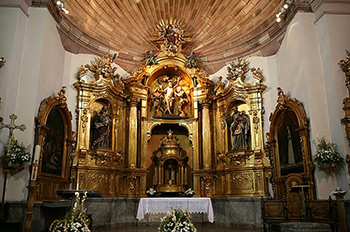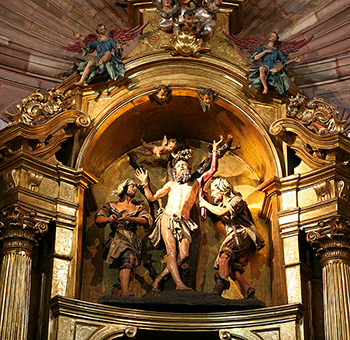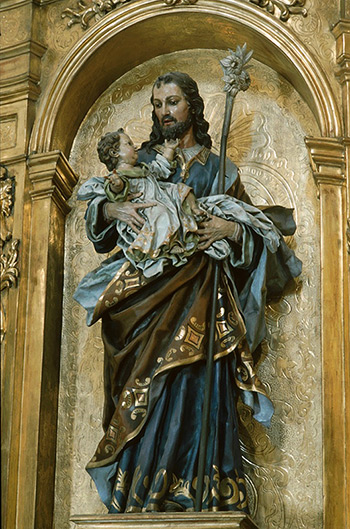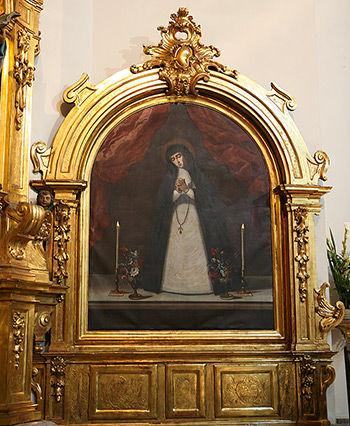Route through the 18th century altarpieces of Baztania
The A Lekaroz group
The altarpieces of Lekaroz are also the work of Silvestre de Soria. The patrons in this case were the Jáuregui and Aldecoa family of the palace of the Oharriz armory corporal. The three sons of the house achieved celebrity: Don Agustín (1711-1784), who followed the military degree program becoming viceroy of Peru; Don Pedro Fermín (1708-1777), canon and archdeacon of the Chamber of the cathedral of Pamplona; and the third, Francisco Martín (1697-1768), with a successful degree program in business in the Court of Madrid and under the protection of the Royal Congregation of San Fermín de los Navarros. The last two stood out in artistic promotion. Don Pedro Fermín, besides having financed the decoration of the great set of the Rococo sacristy of the cathedral of Pamplona, gave several reliquaries, ornaments and sculptures of Luis Salvador Carmona to the parish of Lekaroz, financing the collateral altarpieces, work of Silvestre de Soria, together with his brother Francisco Martín. The latter, after having paid for sculptures by the same master in the Royal Congregation of San Fermín de los Navarros in Madrid, offered carvings of Saint Bartholomew and Saint Matthias to the same parish where he was baptized.
The main altarpiece is the most complex from the typological point of view and was made between 1762 and 1767. The desire to cover the whole of the main chapel with the great scenographic machine prevailed. It was planned as a great triptych with the central street more outstanding both for its framing between columns and for its height, destined to the great tabernacle-exhibitor and to the sculptural group of the martyrdom of Saint Bartholomew, inspired by the same topic of an etching engraving by Jose Ribera, of 1624. In the two lateral wings are venerated the images of Saint Joseph, donated by Don José de Echeverría y Larreche between 1756 and 1758, and that of Saint Bartholomew, a gift from Don Francisco Martín Jáuregui (1753-1756). As in Azpilkueta, the sculptures preceded the making of the altarpieces.
The credenzas with their paintings are located on the sides of the great triptych. The one of the Virgin of Solitude was paid for, between 1770 and 1772, by Don Juan de Iturralde, owner of the palace of Aroztegi, while the one of the Pietà or Descent from the Cross was donated by the archdeacon Don Pedro Fermín de Jáuregui who, out of devotion to the Passion of Christ, gave the Descent from the Cross with Our Lady of Sorrows, its bulk and gilding.
The collateral altarpieces, dedicated to the Virgin of the Rosary and Saint Barbara, were financed, between 1762 and 1767, by the brothers Pedro Fermín and Francisco Martín de Jáuregui, mentioned above, the former a Pamplona archdeacon and the latter a businessman in Madrid who came to spend his last years in Lekaroz, paying for the family palace in 1748. The sculpture of the Virgin of the Rosary, work of Carmona in 1756, was a donation of the canon Pedro Fermín de Jáuregui. The image of Saint Catherine is of inferior quality, probably the work of Martín de Ontañón, noted as a gift from Francisco Martín, 1770, but probably made between 1762 and 1767.
Regarding the artists of the group, for Silvestre de Soria we refer to what we have noted in the Azpilkueta altarpieces. Regarding Luis Salvador Carmona, let us remember that he is considered one of the leading figures of Spanish sculpture, who exported from the Villa y Corte numerous works throughout the peninsular geography. He was born in 1708 in Nava del Rey (Valladolid) and learned his official document with the sculptor Juan Villabrille y Ron. His best works are sculptures in polychrome wood, in which there is room for hairpieces, such as glass eyes. His art is characterized by realism, avoiding crudeness and making kind expressions. The Catalog of his work is long in issue, it extends in time, practically until his death in 1767, although he always maintained a constant style in the virtuous execution.
CRUZ YABAR, M. T., "José de Hermosilla y el retablo de Irurita en Navarra", file Español de Arte, n.º 290 (2000), pp. 51-65.
FERNÁNDEZ GRACIA, R., El retablo barroco en Navarra, Pamplona, Government of Navarre, 2003.
FERNÁNDEZ GRACIA, R., "El triunfo del Academicismo en los retablos baztaneses y el project para el mayor de Villafranca (1783) en un dibujo de la Library Services Nacional", Studium, Magisterium et amicitia. Homage to professor Agustín González Enciso (ed. R. Torres Sánchez), Pamplona, Eunate, 2018, pp. 467-478.
FERNÁNDEZ GRACIA, R., "En torno a la registration de la Virgen del Rosario de Irurita, obra de Juan Domingo Olivieri, de 1749", Pieza del mes de marzo de 2023. Chair de Patrimonio y Arte Navarro.
GARCÍA GAINZA, M.ª C., "Virgen del Rosario, signed by Olivieri", file Español de Arte, n.º 235 (1986), pp. 324-329.
GARCÍA GAINZA, M.ª C., El escultor Luis Salvador Carmona, Pamplona, University of Navarra, 1990.
GARCÍA GAINZA, M.ª C., "Sobre las esculturas de Luis Salvador Carmona en Lekaroz", Cuadernos de la Chair de Patrimonio y Arte Navarro, n.º 2, Pamplona, 2008, pp. 243-255.
GARCÍA GAÍNZA, M.ª C., "Alonso Cano y José Ribera, fuentes inspiradoras en la obra de Luis Salvador Carmona: el martirio de san Bartolomé de Lekaroz", Pieza del mes de mayo de 2015. Chair de Patrimonio y arte navarro.
MARTÍN GONZÁLEZ, J. J., "Problemática del retablo bajo Carlos III", Fragmentos n.º 12-14 (1988), pp. 33-43.













